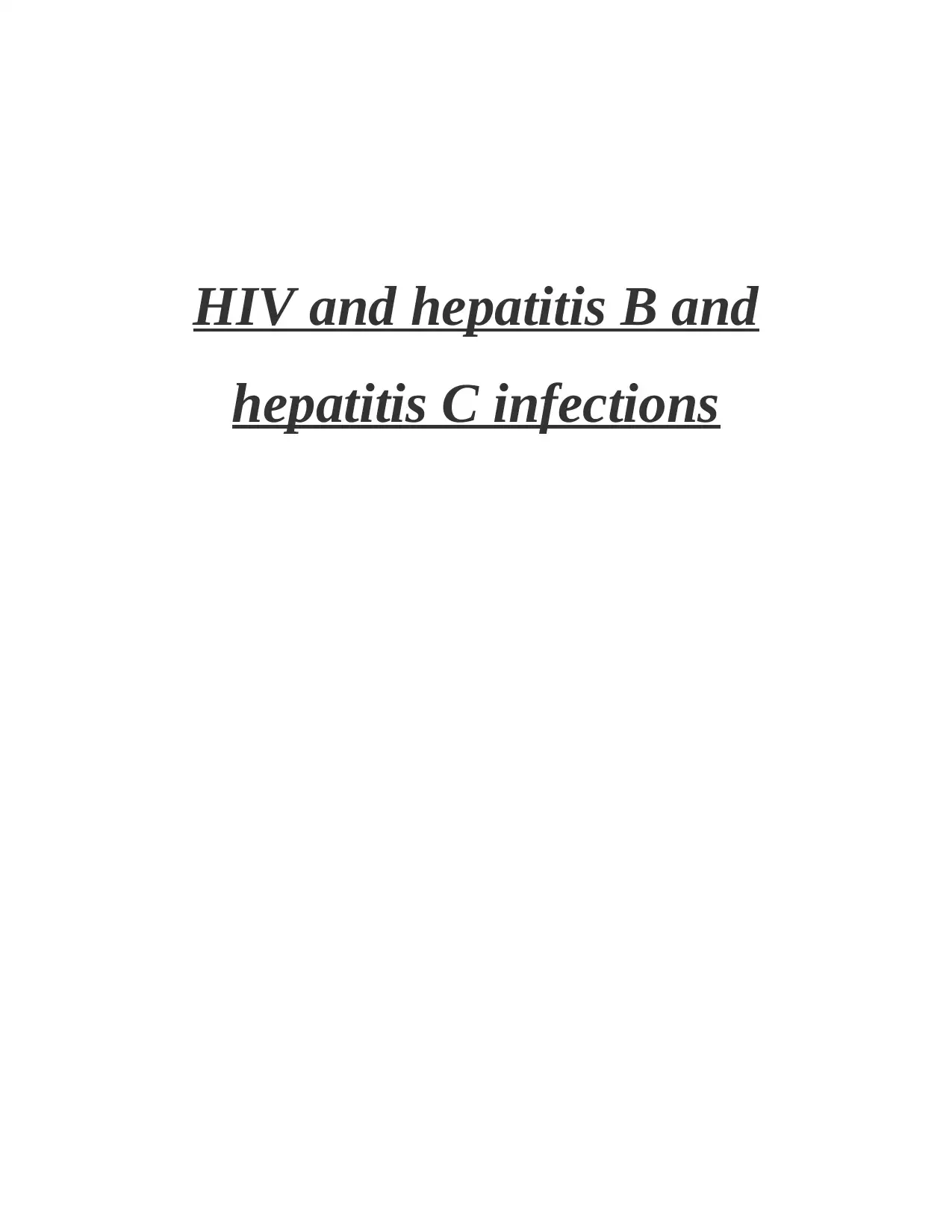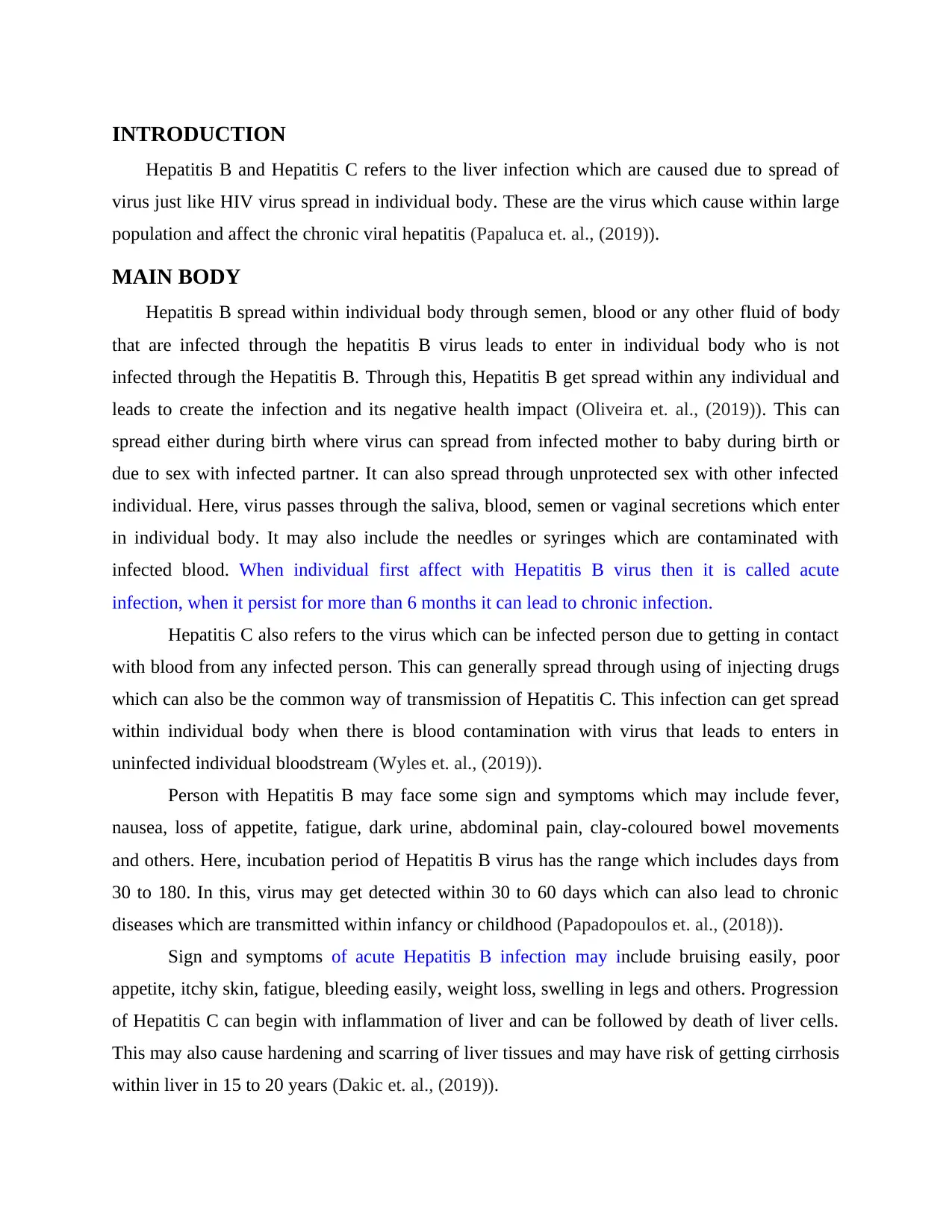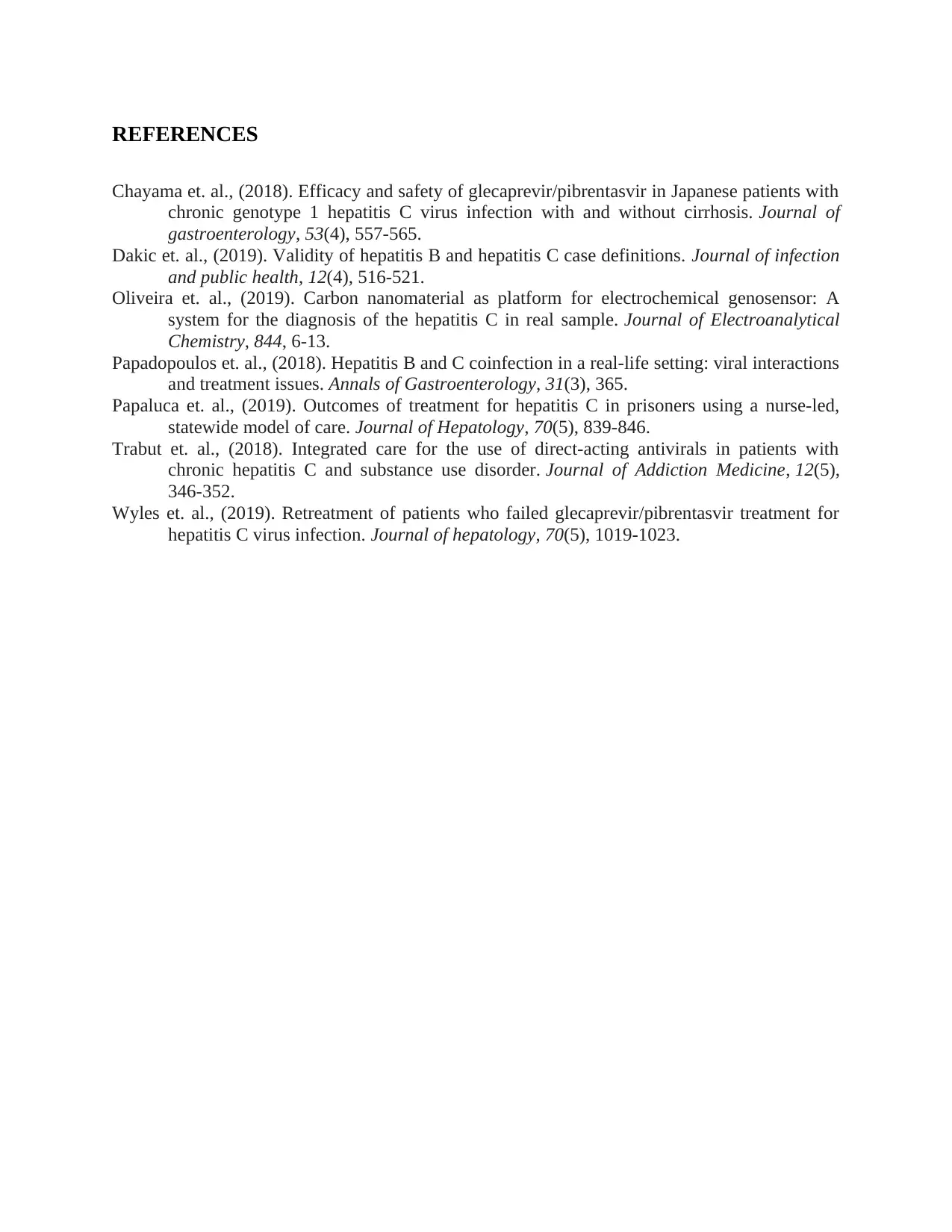Detailed Study: Transmission, Symptoms & Prevention of HIV & Hepatitis
VerifiedAdded on 2023/06/14
|5
|960
|248
Report
AI Summary
This report provides an overview of HIV, Hepatitis B, and Hepatitis C infections, detailing their transmission routes, symptoms, and prevention strategies. Hepatitis B spreads through bodily fluids like semen and blood, while Hepatitis C primarily spreads through blood contact. Symptoms of these infections include fever, nausea, fatigue, and abdominal pain. Prevention strategies for Hepatitis B include vaccination, safe sex practices, and avoiding contact with infected bodily fluids. Preventing Hepatitis C involves avoiding sharing needles and practicing safe sex. The report emphasizes the importance of preventing these infections to avoid chronic liver diseases. Desklib provides more solved assignments and resources for students.

HIV and hepatitis B and
hepatitis C infections
hepatitis C infections
Paraphrase This Document
Need a fresh take? Get an instant paraphrase of this document with our AI Paraphraser

Table of Contents
INTRODUCTION...........................................................................................................................3
MAIN BODY...................................................................................................................................3
CONCLUSION................................................................................................................................4
REFERENCES................................................................................................................................5
INTRODUCTION...........................................................................................................................3
MAIN BODY...................................................................................................................................3
CONCLUSION................................................................................................................................4
REFERENCES................................................................................................................................5

INTRODUCTION
Hepatitis B and Hepatitis C refers to the liver infection which are caused due to spread of
virus just like HIV virus spread in individual body. These are the virus which cause within large
population and affect the chronic viral hepatitis (Papaluca et. al., (2019)).
MAIN BODY
Hepatitis B spread within individual body through semen, blood or any other fluid of body
that are infected through the hepatitis B virus leads to enter in individual body who is not
infected through the Hepatitis B. Through this, Hepatitis B get spread within any individual and
leads to create the infection and its negative health impact (Oliveira et. al., (2019)). This can
spread either during birth where virus can spread from infected mother to baby during birth or
due to sex with infected partner. It can also spread through unprotected sex with other infected
individual. Here, virus passes through the saliva, blood, semen or vaginal secretions which enter
in individual body. It may also include the needles or syringes which are contaminated with
infected blood. When individual first affect with Hepatitis B virus then it is called acute
infection, when it persist for more than 6 months it can lead to chronic infection.
Hepatitis C also refers to the virus which can be infected person due to getting in contact
with blood from any infected person. This can generally spread through using of injecting drugs
which can also be the common way of transmission of Hepatitis C. This infection can get spread
within individual body when there is blood contamination with virus that leads to enters in
uninfected individual bloodstream (Wyles et. al., (2019)).
Person with Hepatitis B may face some sign and symptoms which may include fever,
nausea, loss of appetite, fatigue, dark urine, abdominal pain, clay-coloured bowel movements
and others. Here, incubation period of Hepatitis B virus has the range which includes days from
30 to 180. In this, virus may get detected within 30 to 60 days which can also lead to chronic
diseases which are transmitted within infancy or childhood (Papadopoulos et. al., (2018)).
Sign and symptoms of acute Hepatitis B infection may include bruising easily, poor
appetite, itchy skin, fatigue, bleeding easily, weight loss, swelling in legs and others. Progression
of Hepatitis C can begin with inflammation of liver and can be followed by death of liver cells.
This may also cause hardening and scarring of liver tissues and may have risk of getting cirrhosis
within liver in 15 to 20 years (Dakic et. al., (2019)).
Hepatitis B and Hepatitis C refers to the liver infection which are caused due to spread of
virus just like HIV virus spread in individual body. These are the virus which cause within large
population and affect the chronic viral hepatitis (Papaluca et. al., (2019)).
MAIN BODY
Hepatitis B spread within individual body through semen, blood or any other fluid of body
that are infected through the hepatitis B virus leads to enter in individual body who is not
infected through the Hepatitis B. Through this, Hepatitis B get spread within any individual and
leads to create the infection and its negative health impact (Oliveira et. al., (2019)). This can
spread either during birth where virus can spread from infected mother to baby during birth or
due to sex with infected partner. It can also spread through unprotected sex with other infected
individual. Here, virus passes through the saliva, blood, semen or vaginal secretions which enter
in individual body. It may also include the needles or syringes which are contaminated with
infected blood. When individual first affect with Hepatitis B virus then it is called acute
infection, when it persist for more than 6 months it can lead to chronic infection.
Hepatitis C also refers to the virus which can be infected person due to getting in contact
with blood from any infected person. This can generally spread through using of injecting drugs
which can also be the common way of transmission of Hepatitis C. This infection can get spread
within individual body when there is blood contamination with virus that leads to enters in
uninfected individual bloodstream (Wyles et. al., (2019)).
Person with Hepatitis B may face some sign and symptoms which may include fever,
nausea, loss of appetite, fatigue, dark urine, abdominal pain, clay-coloured bowel movements
and others. Here, incubation period of Hepatitis B virus has the range which includes days from
30 to 180. In this, virus may get detected within 30 to 60 days which can also lead to chronic
diseases which are transmitted within infancy or childhood (Papadopoulos et. al., (2018)).
Sign and symptoms of acute Hepatitis B infection may include bruising easily, poor
appetite, itchy skin, fatigue, bleeding easily, weight loss, swelling in legs and others. Progression
of Hepatitis C can begin with inflammation of liver and can be followed by death of liver cells.
This may also cause hardening and scarring of liver tissues and may have risk of getting cirrhosis
within liver in 15 to 20 years (Dakic et. al., (2019)).
⊘ This is a preview!⊘
Do you want full access?
Subscribe today to unlock all pages.

Trusted by 1+ million students worldwide

There are some of the strategies which may help to prevent the spread of hepatitis B
which include vaccination as the priority (Chayama et. al., (2018)). Others may include washing
of hand with soap and water or any other potential exposure to blood. Individual should use
condoms with their sexual partners. There is also need to avoid the direct contact with body fluid
or blood. There is need to avoid the risk of spread of diseases, it also includes the injecting drugs
can be effective preventive strategy for Hepatitis C.
Individual should ensure to avoid sharing of needles, should not share personal care
items, practice safe sex, avoid direct exposure to blood or any other body fluid.
There is no any chance that individual may get twice infection of Hepatitis B. .There is
need to prevent hepatitis B and C because it can lead to cause irritation or inflammation along
with swelling of liver and may also lead to chronic liver disease (Trabut et. al., (2018)).
which include vaccination as the priority (Chayama et. al., (2018)). Others may include washing
of hand with soap and water or any other potential exposure to blood. Individual should use
condoms with their sexual partners. There is also need to avoid the direct contact with body fluid
or blood. There is need to avoid the risk of spread of diseases, it also includes the injecting drugs
can be effective preventive strategy for Hepatitis C.
Individual should ensure to avoid sharing of needles, should not share personal care
items, practice safe sex, avoid direct exposure to blood or any other body fluid.
There is no any chance that individual may get twice infection of Hepatitis B. .There is
need to prevent hepatitis B and C because it can lead to cause irritation or inflammation along
with swelling of liver and may also lead to chronic liver disease (Trabut et. al., (2018)).
Paraphrase This Document
Need a fresh take? Get an instant paraphrase of this document with our AI Paraphraser

REFERENCES
Chayama et. al., (2018). Efficacy and safety of glecaprevir/pibrentasvir in Japanese patients with
chronic genotype 1 hepatitis C virus infection with and without cirrhosis. Journal of
gastroenterology, 53(4), 557-565.
Dakic et. al., (2019). Validity of hepatitis B and hepatitis C case definitions. Journal of infection
and public health, 12(4), 516-521.
Oliveira et. al., (2019). Carbon nanomaterial as platform for electrochemical genosensor: A
system for the diagnosis of the hepatitis C in real sample. Journal of Electroanalytical
Chemistry, 844, 6-13.
Papadopoulos et. al., (2018). Hepatitis B and C coinfection in a real-life setting: viral interactions
and treatment issues. Annals of Gastroenterology, 31(3), 365.
Papaluca et. al., (2019). Outcomes of treatment for hepatitis C in prisoners using a nurse-led,
statewide model of care. Journal of Hepatology, 70(5), 839-846.
Trabut et. al., (2018). Integrated care for the use of direct-acting antivirals in patients with
chronic hepatitis C and substance use disorder. Journal of Addiction Medicine, 12(5),
346-352.
Wyles et. al., (2019). Retreatment of patients who failed glecaprevir/pibrentasvir treatment for
hepatitis C virus infection. Journal of hepatology, 70(5), 1019-1023.
Chayama et. al., (2018). Efficacy and safety of glecaprevir/pibrentasvir in Japanese patients with
chronic genotype 1 hepatitis C virus infection with and without cirrhosis. Journal of
gastroenterology, 53(4), 557-565.
Dakic et. al., (2019). Validity of hepatitis B and hepatitis C case definitions. Journal of infection
and public health, 12(4), 516-521.
Oliveira et. al., (2019). Carbon nanomaterial as platform for electrochemical genosensor: A
system for the diagnosis of the hepatitis C in real sample. Journal of Electroanalytical
Chemistry, 844, 6-13.
Papadopoulos et. al., (2018). Hepatitis B and C coinfection in a real-life setting: viral interactions
and treatment issues. Annals of Gastroenterology, 31(3), 365.
Papaluca et. al., (2019). Outcomes of treatment for hepatitis C in prisoners using a nurse-led,
statewide model of care. Journal of Hepatology, 70(5), 839-846.
Trabut et. al., (2018). Integrated care for the use of direct-acting antivirals in patients with
chronic hepatitis C and substance use disorder. Journal of Addiction Medicine, 12(5),
346-352.
Wyles et. al., (2019). Retreatment of patients who failed glecaprevir/pibrentasvir treatment for
hepatitis C virus infection. Journal of hepatology, 70(5), 1019-1023.
1 out of 5
Related Documents
Your All-in-One AI-Powered Toolkit for Academic Success.
+13062052269
info@desklib.com
Available 24*7 on WhatsApp / Email
![[object Object]](/_next/static/media/star-bottom.7253800d.svg)
Unlock your academic potential
Copyright © 2020–2025 A2Z Services. All Rights Reserved. Developed and managed by ZUCOL.





